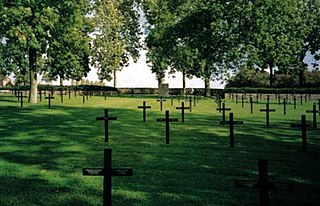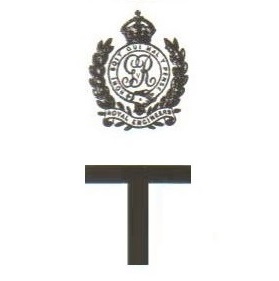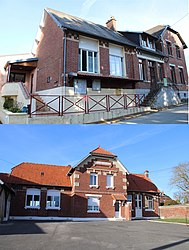
Somme is a department of France, located in the north of the country and named after the Somme river. It is part of the Hauts-de-France region. It had a population of 570,559 in 2019.

The arrondissement of Péronne is an arrondissement of France in the Somme department in the Hauts-de-France region. It has 208 communes. Its population is 94,895 (2016), and its area is 1,484.6 km2 (573.2 sq mi).
The Mametz Wood Memorial commemorates an engagement of the 38th (Welsh) Division of the British Army during the First Battle of the Somme in France in 1916.

Fricourt is a commune in the Somme department in Hauts-de-France in northern France.

Mametz is a commune in the Pas-de-Calais department in the Hauts-de-France region of France.

Bray-sur-Somme is a commune in the Somme department in Hauts-de-France in northern France.

Camon is a commune in the Somme department in Hauts-de-France in northern France.

Carnoy is a former commune in the Somme department in Hauts-de-France in northern France. On 1 January 2019, it was merged into the new commune Carnoy-Mametz.

Mametz is a former commune in the Somme department in Hauts-de-France in northern France. On 1 January 2019, it was merged into the new commune Carnoy-Mametz.
The Canton of Albert is a canton situated in the department of the Somme and in the Hauts-de-France region of northern France.
The Canton of Combles is a former canton situated in the department of the Somme and in the Picardie region of northern France. It was disbanded following the French canton reorganisation which came into effect in March 2015. It had 4,422 inhabitants (2012).
The Communauté de communes du Pays du Coquelicot is a communauté de communes in the Somme département and in the Hauts-de-France région of France. Its population is 28,302 (2018).
The communauté de communes du canton de Combles is a former communauté de communes in the Somme département and in the Picardie region of France. It was created in December 1993. It was merged into the Communauté de communes de la Haute Somme in 2013.
Livens Large Gallery Flame Projectors were large experimental flamethrowers used by the British Army in World War I, named after their inventor, Royal Engineers officer William Howard Livens.
The 100th Brigade was a formation of the British Army founded during World War I. It was raised as part of the new army also known as Kitchener's Army and assigned to the 33rd Division. The brigade served on the Western Front. The brigade saw additional action during Britain's involvement in Vietnam following the Second World War.

The Capture of Montauban, took place on 1 July 1916, the first day of the Battle of the Somme, between the British Fourth Army and the French Sixth Army against the German 2nd Army, on the Western Front, during the First World War. Montauban is a commune in the Somme départment in Picardy in northern France and lies on the D 64, between Guillemont to the east and Mametz to the west. To the north are Bazentin-le-Petit and Bazentin-le-Grand. Bernafay and Trônes woods are to the north-east and Maricourt lies to the south.

The Capture of Mametz took place on 1 July 1916, when the British Fourth Army attacked the German 2nd Army on the Western Front, during the first day of the Battle of the Somme. Mametz is a village on the D 64 road, about 20 mi (32 km) north-east of Amiens and 4 mi (6.4 km) east of Albert. Fricourt lies to the west, Contalmaison is to the north, Montauban to the north-east and Carnoy and Maricourt are to the south-east. Mametz Wood is 1,000 yd (910 m) to the north-west and before 1914, the village was the fifth largest in the area, with about 120 houses and had a station on the line from Albert to Péronne. During the Battle of Albert (25 to 29 September) 1914 the II Bavarian Corps attacked westwards north of the Somme but was fought to a standstill east of Mametz. Reinforced by the XIV Reserve Corps the Germans on the north side of the Somme attacked again and took Mametz on 29 September. After a mutually costly battle for Fricourt, where the French were eventually forced out, the front line stabilised and both sides began to dig improvised defences. In mid-December the French conducted a local attack in the Mametz area but were repulsed with many casualties.

The 174th Tunnelling Company was one of the tunnelling companies of the Royal Engineers created by the British Army during World War I. The tunnelling units were occupied in offensive and defensive mining involving the placing and maintaining of mines under enemy lines, as well as other underground work such as the construction of deep dugouts for troop accommodation, the digging of subways, saps, cable trenches and underground chambers for signals and medical services.

The 183rd Tunnelling Company was one of the tunnelling companies of the Royal Engineers created by the British Army during World War I. The tunnelling units were occupied in offensive and defensive mining involving the placing and maintaining of mines under enemy lines, as well as other underground work such as the construction of deep dugouts for troop accommodation, the digging of subways, saps, cable trenches and underground chambers for signals and medical services.

On the morning of 1 July 1916, the first day of the Battle of the Somme during World War I, underground explosive charges planted by British tunnelling units were detonated beneath the German front lines. The joint explosion of these mines ranks among the largest artificial non-nuclear explosions.















